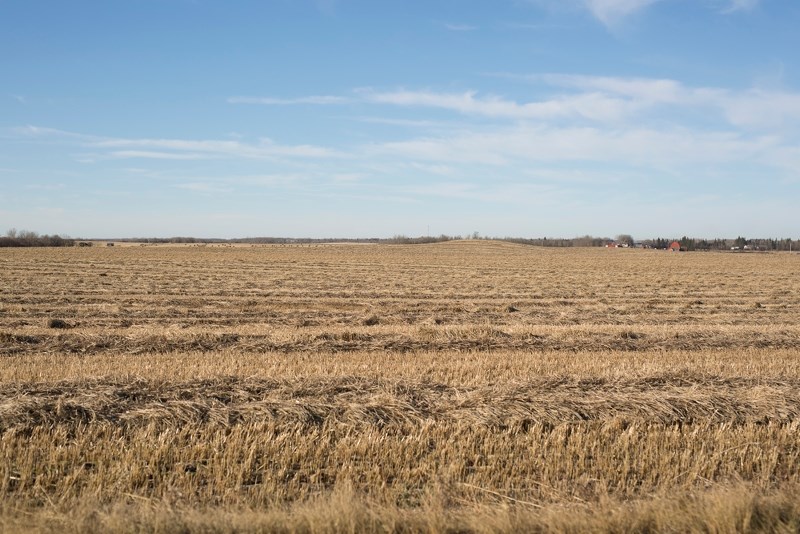Farmers in the area continue to push ahead, battling Mother Nature in a fight to bring the harvest season to a close.
“Basically, it’s a slow process,” said County of St. Paul Agricultural Fieldman Dennis Bergheim, last week. At that time, he estimated that about 20 to 25 per cent of crops were waiting to be taken off the ground.
Bergheim also noted that many farmers have been facing equipment issues and costly repairs, due to the challenges facing them with the unusually wet weather. Overall, many producers are frustrated, and are wondering if they will ever see an end to this year’s harvest.
Andrew Yaremko has been farming since 1998, with his dad farming for decades longer.
“Not even my dad, who has been farming for about 50 years, has seen it like this,” says Yaremko. Although there have certainly been some challenging years, with cold, wintery weather, the amount of rain and moisture seen this fall seems to be unprecedented.
Yaremko and his wife, Erin, have about 300 cows, and along with doing silage, and baling close to 800 bales a year, they also harvest about 300 acres worth of cereal crops.
Not only has harvest been a challenge, but also other seasonal things have proven to be difficult in the wet weather.
“Our biggest thing this year is you’re always going to plan B,” says Yaremko. Even weaning calves was harder, with how much mud there was in the pens.
Where and how to feed cattle is also something that has been juggled.
“We had a ton of feed out in the field . . . but we couldn’t get in the fields,” says Yaremko. “It’s a disheartening feeling.”
Now that the ground is starting to freeze, some things may be a little easier.
Last week, the Yaremko family decided to do their corn silage, something they had been waiting on doing for well over a month. “We were able to get it done,” says Andrew, but it wasn’t without its challenges.
“We did 136 loads, and got stuck 18 times.”
Late last week, Yaremko still had some cereals to combine, but he was hoping to get that done soon. Unlike some farmers who may decide to wait until spring, Yaremko says he won’t, since one crop is already germinating, according to test samples.
The samples show dry areas, wet areas, and germinating seed.
“We’re probably going to start again here in the next day or two, once it freezes harder.”
Bailing straw was also a challenge. In some areas, the straw would be dry, and then suddenly the baler would be plugged with a wet lump. Yaremko says he heard from one of the equipment dealer in the Lakeland that it is typical for them to sell about 75 belts in a season – this year that same business sold 500 belts.
He notes that there is a balance to pushing ahead, while not wrecking equipment, but it’s a hard one to manage.
Combining this late in the season also gives rodents a chance to get comfortable in the swaths, and finding mice hiding in the crops isn’t uncommon. The mice run through the combine, which is one more challenge to add to the growing list.
“It’s been a tough year for everybody,” concedes Yaremko. Although he may be wrapping up his season this week, he knows there are many farmers in the area that will continue to struggle, as they too continue to push ahead.
Coral and Shaun Robinson’s youngest child was two weeks old and weighed 9lbs, when he went for his first combine ride at the start of the harvest season. Now, he’s almost 15lbs and three months old, which puts the long season into a whole new perspective for the Robinson family.
“It's sure been a long season,” says Coral, who farms alongside her husband, halfway between St. Paul and Bonnyville. “We've just tried to use humour, and keeping busy with other farm stuff on the snowy or rainy days to get through this. We still have about 10 per cent in the field.”
Thankfully, Coral says she feels like they are now on the home stretch, and getting to the end of harvest. Some producers in the area are fortunate enough to have grain dryers to help deal with the amount of moisture, but the Robinsons do not.
“Everything we took off before the first big snow was dry, and everything after has been tough,” says Coral. “There’s always the question if we can market the tough grain before it spoils, or if we've got to haul it to a grain dryer and then back home, which all has its added costs.”
For Coral, this season has been the most challenging harvest that she can recall.
“My grandparents recall a year like this shortly after they moved to Canada about 50 years ago,” says Coral, adding, “I honestly think this is one of the bigger agricultural disasters that I can remember. This is not just here, this is all of Western Canada.”
She points to the fact that prior to the wet fall season, the crops were looking great. And the problem with accessing crop insurance is that it is often based on yield.
“The yields are there but the crops are still in the fields and the quality is gone.”
On top of a tough harvest, the cattle market has also taken a hit this year, and a new challenge has erupted in southern Alberta and into Saskatchewan where cattle producers are dealing with a bovine tuberculosis investigation.
Despite the uncertainties that come with the challenges, loans, and bills that continue to pile up, Coral has confidence in her fellow producers.
“Farmers are a resilient bunch. We will get through this. I know there is a lot of stress floating around in the farming community right now, but soon winter is going to set in and despite our worries, some of it is just beyond our control.”



